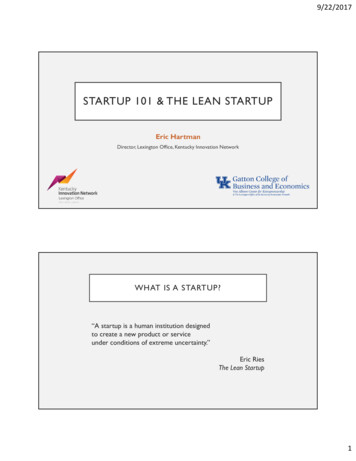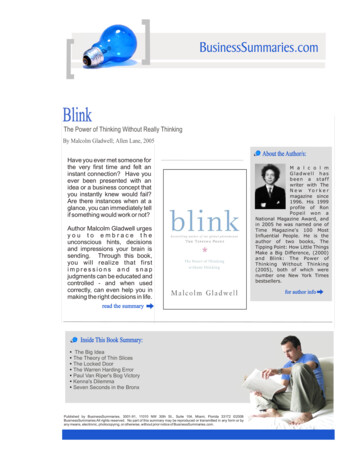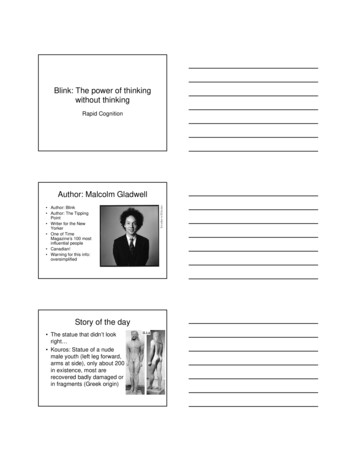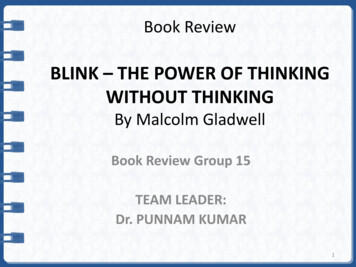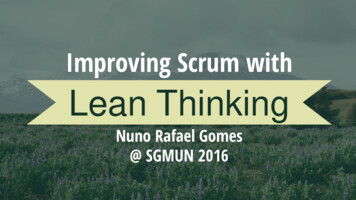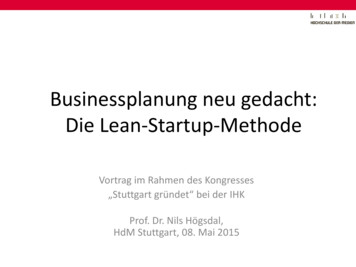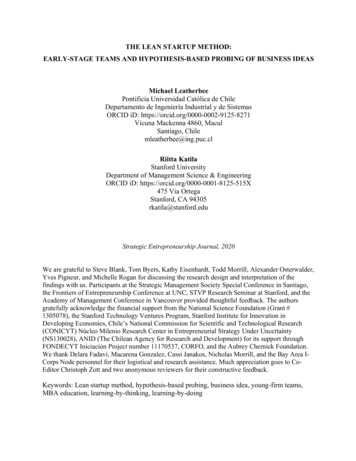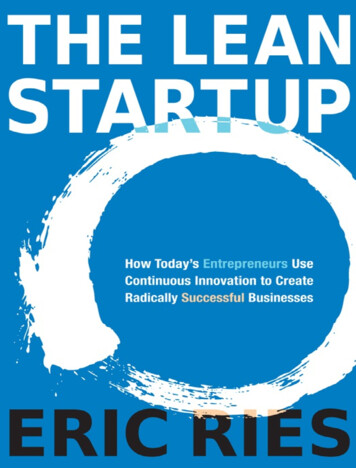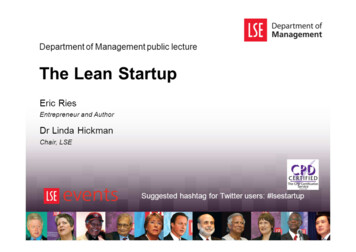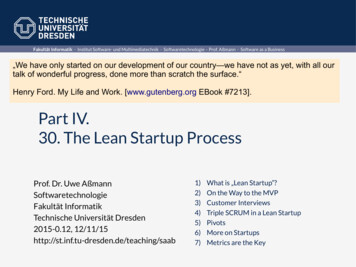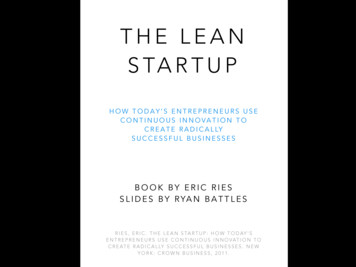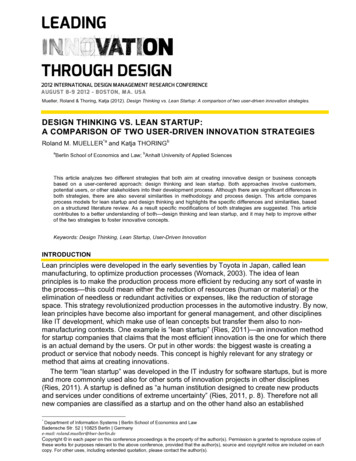
Transcription
Mueller, Roland & Thoring, Katja (2012). Design Thinking vs. Lean Startup: A comparison of two user-driven innovation strategies.DESIGN THINKING VS. LEAN STARTUP:A COMPARISON OF TWO USER-DRIVEN INNOVATION STRATEGIESRoland M. MUELLER*a and Katja THORINGbabBerlin School of Economics and Law; Anhalt University of Applied SciencesThis article analyzes two different strategies that both aim at creating innovative design or business conceptsbased on a user-centered approach: design thinking and lean startup. Both approaches involve customers,potential users, or other stakeholders into their development process. Although there are significant differences inboth strategies, there are also several similarities in methodology and process design. This article comparesprocess models for lean startup and design thinking and highlights the specific differences and similarities, basedon a structured literature review. As a result specific modifications of both strategies are suggested. This articlecontributes to a better understanding of both—design thinking and lean startup, and it may help to improve eitherof the two strategies to foster innovative concepts.Keywords: Design Thinking, Lean Startup, User-Driven InnovationINTRODUCTIONLean principles were developed in the early seventies by Toyota in Japan, called leanmanufacturing, to optimize production processes (Womack, 2003). The idea of leanprinciples is to make the production process more efficient by reducing any sort of waste inthe process—this could mean either the reduction of resources (human or material) or theelimination of needless or redundant activities or expenses, like the reduction of storagespace. This strategy revolutionized production processes in the automotive industry. By now,lean principles have become also important for general management, and other disciplineslike IT development, which make use of lean concepts but transfer them also to nonmanufacturing contexts. One example is “lean startup” (Ries, 2011)—an innovation methodfor startup companies that claims that the most efficient innovation is the one for which thereis an actual demand by the users. Or put in other words: the biggest waste is creating aproduct or service that nobody needs. This concept is highly relevant for any strategy ormethod that aims at creating innovations.The term “lean startup” was developed in the IT industry for software startups, but is moreand more commonly used also for other sorts of innovation projects in other disciplines(Ries, 2011). A startup is defined as “a human institution designed to create new productsand services under conditions of extreme uncertainty” (Ries, 2011, p. 8). Therefore not allnew companies are classified as a startup and on the other hand also an established*Department of Information Systems Berlin School of Economics and LawBadensche Str. 52 10825 Berlin Germanye- ‐mail:roland.mueller@hwr- ‐berlin.deCopyright in each paper on this conference proceedings is the property of the author(s). Permission is granted to reproduce copies ofthese works for purposes relevant to the above conference, provided that the author(s), source and copyright notice are included on eachcopy. For other uses, including extended quotation, please contact the author(s).
Roland M. Mueller and Katja Thoringdepartment in a big company could be a startup. Lean startup evolved from the “customerdevelopment” method (Blank, 2006). The idea behind these methods is, that in addition to aprocess for “product development”, a startup also needs a process for “customerdevelopment” to find and understand the customers. This leads to developing solutionsbased on a user-centered approach and adapting to customer needs. Within this article, wemainly use the term “lean startup” instead of “customer development”, to highlight the leanaspects of the method. The aim of lean startup is to build a continuous feedback loop withcustomers during product development cycles (Maurya, 2012). It tries to test the corebusiness assumptions early in the product development process, sometimes even beforeany product is built at all.Another user-driven innovation strategy that has become more and more popular duringthe last decades is “design thinking”. Based on designerly methods and principles, thisstrategy was developed by the design consultancy IDEO in the late 90s (Kelley & Littman,2001). Although it is not referring to lean principles, the main idea behind it is similar: it triesto identify user needs in order to create appropriate solutions.Similar to lean startup, design thinking is also focusing on users or customers. Based on auser-centered approach with multi-disciplinary teams, it aims at solving complex (wicked)problems (Buchanan, 1992; Rittel, 1972) and at generating innovative solutions. Designthinking makes use of extensive user research, feedback loops and iteration cycles. It isbecoming more and more popular among business schools (e.g. the Rotman School ofManagement (Martin, 2009)), and it is applied in R&D departments of companies to fosterinnovation.This paper provides a structured analysis and comparison of the two innovationstrategies—lean startup and design thinking—with the goal to identify potentials to enricheither of the two by merging or adapting specific parts or aspects.The article is structured as follows: The first section presents an extensive literaturereview that also provides short introductions of both, lean startup and design thinking, andwhich is then used as a basis for a comparison of the two strategies. The differentcharacteristics are summarized in a structured framework, highlighting similarities, gaps, anddifferences in naming conventions of both strategies. In conclusion we suggest somemodifications and intersections of the two processes, in order to reveal potential to enricheither of the two.COMPARATIVE LITERATURE REVIEWFor re-engineering the two strategies, we analyze two types of data sources about leanstartup and design thinking: 1) published literature and case studies, and 2) process modelsfor the two different processes. We are aware that design thinking as well as lean startup arenot just processes but consist also of tacit elements, like practices, experiences, specificmind-sets, and company cultures (Thoring & Müller, 2011a). These intangible elements areimportant and not everything in both methods can be made explicit and reduced to aprocess description. However, we think that a detailed comparison of the process steps isstill useful to better understand both innovation approaches.The insights from these two data sources, such as similarities and differences, are thensummarized in a structured framework, which can be found in Table 1.PUBLISHED LITERATURE AND CASE STUDIESFirst, we analyze relevant literature and published case studies for both strategies (e.g.Blank (2006), Blank & Dorf (2012), Brown (2008), Brown (2009), Cooper & Vlaskovits(2010), Kelley & Littman (2001), Kelley & Littman (2005), Kolko (2011), Martin (2009),2
Design thinking vs. Lean StartupMaurya (2012), Plattner, Meinel & Leifer (2011), Plattner, Meinel & Weinberg (2009), Ries(2011), Sims (2011), and Thoring & Müller (2011a, 2011b, 2011c)). The literature reviewreveals that the two communities of lean startup and design thinking do not interact and citeeach other very often. They use similar methods and tools, but have developed differentnames for them. This reveals potential for learning from each other strategy.ABSTRACT PROCESS MODELSAs the second step, we compare the two strategies based on process models. However, forboth methods there is not one defined process model available. Moreover, the descriptionsof the processes are often informal and there exist various versions of the process becauseof adjustments and further developments. Therefore we use different types of processmodels: We compare two abstract models—a design thinking process model by Plattner etal. (2009) and the “lean learning cycle” (Ries, 2011), see Figure 1. These abstracted modelsallow for the comparison of the two strategies on a meta level: the number of process steps,order, alignment, labeling, frequency, and direction of the different activities can be checkedagainst each other.Figure 1: Comparison of abstracted process models for design thinking (left) and lean startup (right). (Plattneret al., 2009; Ries, 2011),Both process models make use of six process steps. The most significant difference is thatthe lean learning cycle is arranged in a circular form, while the design thinking process isarranged in a linear way. This might suggest that design thinking should be executed insubsequent steps, while lean startup appears to be more flexible. Unlike the design thinkingprocess, which begins with the “Understand” phase, the lean learning cycle has no clearbeginning or ending—the circular alignment of the steps suggests that they are supposed tobe executed in a continuous and repeatedly manner.The goal of the build-measure-learn cycle is learning (Ries, 2011). What is built is basedon a problem or solution hypothesis. The test of a hypothesis is therefore the intendedlearning step. For testing the hypothesis, appropriate metrics must be defined (measurestep). For generating these metrics and then test the hypothesis, an experiment has to bedesigned (build step). Therefore the build-measure-learn cycle could also be regarded as aclassical scientific hypothesis-metric-experiment cycle that starts with the learning goal(theory or hypothesis) and ends with an experiment (prototype) to test the hypothesis.When comparing the individual steps of both processes, some interesting similaritiesbecome obvious: e.g. “learn” in lean startup could be interpreted as “understand” or as “pointof view” in design thinking. “Build” in lean startup might be similar to “prototype” in designthinking. And “measure” in lean startup can either be “observe” or “test” in design thinking.This is in-line with the before-mentioned assumption that the lean learning cycle could startat any step of the process model.3
Roland M. Mueller and Katja ThoringAnd finally, the lean learning cycle might be applied to different levels of a project. On ameta-level, it could be applied to the entire process, and on a micro-level, it could be appliedto specific details (like the color of a signup button). That means, it is possible to zoom intosub-processes and execute the lean learning cycle also for smaller design decisions. Thedesign thinking process model, however, seems to be only applicable to the entire problem;not to specific sub-problems.DETAILED PROCESS MODELSIn addition to these abstract process models, two more detailed process models along withthe related process descriptions are compared: a process model for design thinking basedon method engineering by Thoring and Müller (2011b), and a process model of lean startupby Cooper and Vlaskovits (2010), see Figures 2a and 2b. These detailed process modelsalong with the descriptions provided by the respective authors allow for a content-relatedcomparison of the two strategies: What is happening within each specific step, what kind ofmethods and tools are used, and what is the outcome of each step?Negative Feedback on Design ChallengeNegative Feedback on User NeedsBriefingNegative Feedback on Problem DefinitionNegative Feedback on ConceptNegative Feedback on PrototypeUnderstandObserveInterviewPoint of nsightsMicroTheoryBrainstormQuestionIdeas onPost-itsClusteredIdeas racterProfileFigure 2a. Detailed process model for design thinking (Thoring & Müller, 2011b).Figure 2b. Detailed process model for lean startup (Cooper & Vlaskovits, 2010).The model of the design thinking process (Figure 2a) describes the six steps of the processand the iteration loops that result from the last step 'test'. Notably about this process is that itdoes not start with an idea, but with a problem or a question, instead. Usually the ideas aredeveloped within the process, in the fourth step 'ideation'. Before that, there is an extensive4
Design thinking vs. Lean Startupfocus on the research, where 'understand' means secondary research and 'observe' meansuser research. Here, design thinking makes use of research methods from other disciplinessuch as ethnographic methods and other qualitative methodology. The acquired knowledgeis then condensed into a sort of micro-theory about the problem or the user needs, the 'pointof view' (POV) that is afterwards used to develop solution concepts in the 'ideation' step. It ishere where innovative ideas are developed that aim at solving that previously identifiedproblem or address the users’ needs. The selected idea is then visualized or built('prototype') in order to test it and gather feedback from prospective users ('test'). Accordingto the feedback the concept is iterated, by returning to one of the previous steps. See(Thoring & Müller, 2011b) for a more detailed description of the design thinking process.Figure 2b shows a process model, adapted from the four steps of the “customerdevelopment” process. Lean startup is a trademark by Eric Ries and combines customerdevelopment with ideas of agile software development, lean management (Womack, 2003),and open source software (Ries, 2011). Since there is no explicit process model for leanstartup, we refer to the customer development process, which consists of four steps:‘customer discovery’, ‘customer validation’, ‘customer creation’, and ‘company building’(Blank, 2006). In the customer discovery phase, the founders discover the appropriat
department in a big company could be a startup. Lean startup evolved from the “customer development” method (Blank, 2006). The idea behind these methods is, that in addition to a process for “product development”, a startup also needs a process for “customer development” to find and understand the customers. This leads to developing solutions
